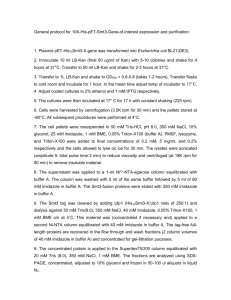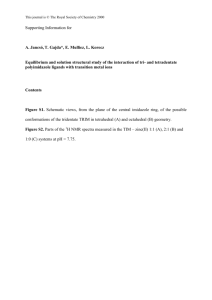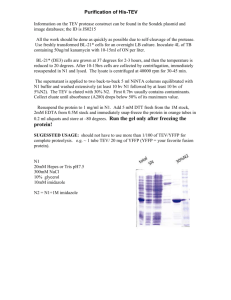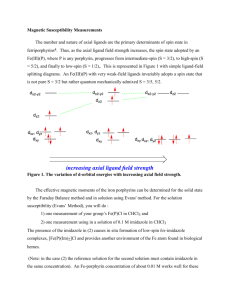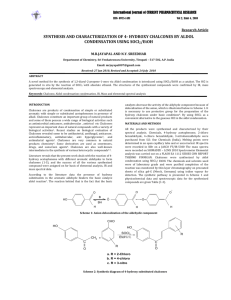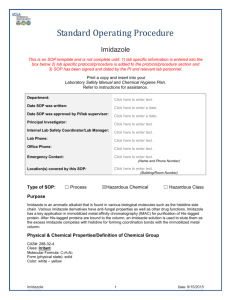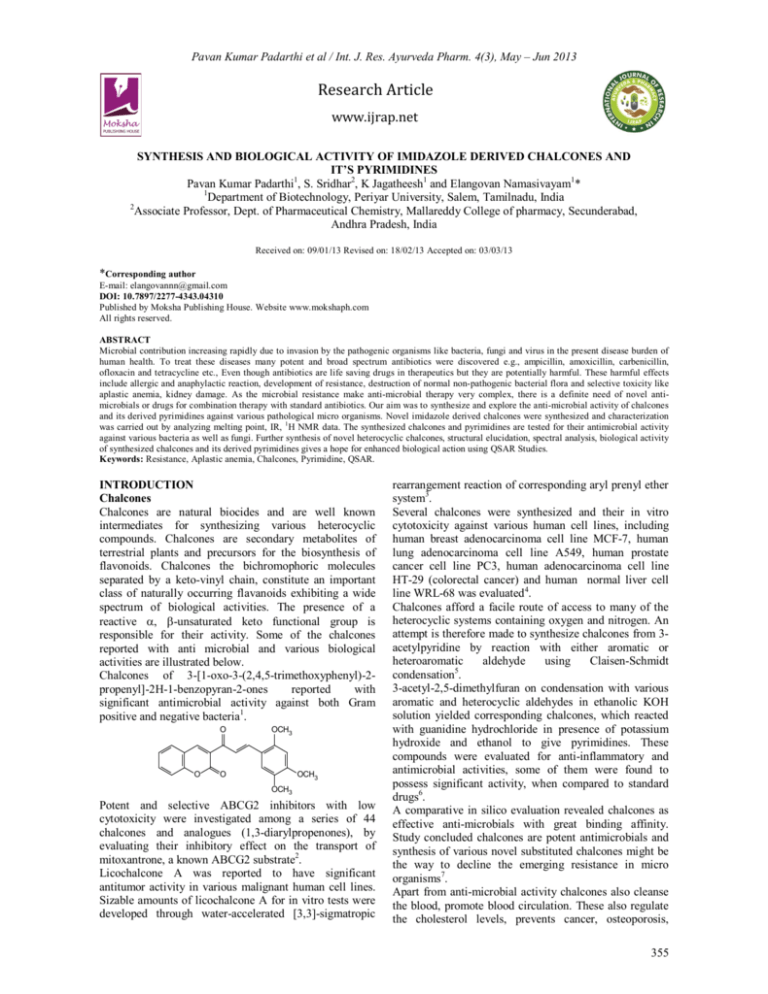
Pavan Kumar Padarthi et al / Int. J. Res. Ayurveda Pharm. 4(3), May – Jun 2013
Research Article
www.ijrap.net
SYNTHESIS AND BIOLOGICAL ACTIVITY OF IMIDAZOLE DERIVED CHALCONES AND
IT’S PYRIMIDINES
Pavan Kumar Padarthi1, S. Sridhar2, K Jagatheesh1 and Elangovan Namasivayam1*
1
Department of Biotechnology, Periyar University, Salem, Tamilnadu, India
2
Associate Professor, Dept. of Pharmaceutical Chemistry, Mallareddy College of pharmacy, Secunderabad,
Andhra Pradesh, India
Received on: 09/01/13 Revised on: 18/02/13 Accepted on: 03/03/13
*Corresponding author
E-mail: elangovannn@gmail.com
DOI: 10.7897/2277-4343.04310
Published by Moksha Publishing House. Website www.mokshaph.com
All rights reserved.
ABSTRACT
Microbial contribution increasing rapidly due to invasion by the pathogenic organisms like bacteria, fungi and virus in the present disease burden of
human health. To treat these diseases many potent and broad spectrum antibiotics were discovered e.g., ampicillin, amoxicillin, carbenicillin,
ofloxacin and tetracycline etc., Even though antibiotics are life saving drugs in therapeutics but they are potentially harmful. These harmful effects
include allergic and anaphylactic reaction, development of resistance, destruction of normal non-pathogenic bacterial flora and selective toxicity like
aplastic anemia, kidney damage. As the microbial resistance make anti-microbial therapy very complex, there is a definite need of novel antimicrobials or drugs for combination therapy with standard antibiotics. Our aim was to synthesize and explore the anti-microbial activity of chalcones
and its derived pyrimidines against various pathological micro organisms. Novel imidazole derived chalcones were synthesized and characterization
was carried out by analyzing melting point, IR, 1H NMR data. The synthesized chalcones and pyrimidines are tested for their antimicrobial activity
against various bacteria as well as fungi. Further synthesis of novel heterocyclic chalcones, structural elucidation, spectral analysis, biological activity
of synthesized chalcones and its derived pyrimidines gives a hope for enhanced biological action using QSAR Studies.
Keywords: Resistance, Aplastic anemia, Chalcones, Pyrimidine, QSAR.
INTRODUCTION
Chalcones
Chalcones are natural biocides and are well known
intermediates for synthesizing various heterocyclic
compounds. Chalcones are secondary metabolites of
terrestrial plants and precursors for the biosynthesis of
flavonoids. Chalcones the bichromophoric molecules
separated by a keto-vinyl chain, constitute an important
class of naturally occurring flavanoids exhibiting a wide
spectrum of biological activities. The presence of a
reactive a, b-unsaturated keto functional group is
responsible for their activity. Some of the chalcones
reported with anti microbial and various biological
activities are illustrated below.
Chalcones of 3-[1-oxo-3-(2,4,5-trimethoxyphenyl)-2propenyl]-2H-1-benzopyran-2-ones
reported
with
significant antimicrobial activity against both Gram
positive and negative bacteria1.
O
O
OCH3
O
OCH3
OCH3
Potent and selective ABCG2 inhibitors with low
cytotoxicity were investigated among a series of 44
chalcones and analogues (1,3-diarylpropenones), by
evaluating their inhibitory effect on the transport of
mitoxantrone, a known ABCG2 substrate2.
Licochalcone A was reported to have significant
antitumor activity in various malignant human cell lines.
Sizable amounts of licochalcone A for in vitro tests were
developed through water-accelerated [3,3]-sigmatropic
rearrangement reaction of corresponding aryl prenyl ether
system3.
Several chalcones were synthesized and their in vitro
cytotoxicity against various human cell lines, including
human breast adenocarcinoma cell line MCF-7, human
lung adenocarcinoma cell line A549, human prostate
cancer cell line PC3, human adenocarcinoma cell line
HT-29 (colorectal cancer) and human normal liver cell
line WRL-68 was evaluated4.
Chalcones afford a facile route of access to many of the
heterocyclic systems containing oxygen and nitrogen. An
attempt is therefore made to synthesize chalcones from 3acetylpyridine by reaction with either aromatic or
heteroaromatic
aldehyde
using
Claisen-Schmidt
condensation5.
3-acetyl-2,5-dimethylfuran on condensation with various
aromatic and heterocyclic aldehydes in ethanolic KOH
solution yielded corresponding chalcones, which reacted
with guanidine hydrochloride in presence of potassium
hydroxide and ethanol to give pyrimidines. These
compounds were evaluated for anti-inflammatory and
antimicrobial activities, some of them were found to
possess significant activity, when compared to standard
drugs6.
A comparative in silico evaluation revealed chalcones as
effective anti-microbials with great binding affinity.
Study concluded chalcones are potent antimicrobials and
synthesis of various novel substituted chalcones might be
the way to decline the emerging resistance in micro
organisms7.
Apart from anti-microbial activity chalcones also cleanse
the blood, promote blood circulation. These also regulate
the cholesterol levels, prevents cancer, osteoporosis,
355
Pavan Kumar Padarthi et al / Int. J. Res. Ayurveda Pharm. 4(3), May – Jun 2013
reduces blood pressure and blood sugar, reduces allergy
and sinus problem, improves vision and memory, aids
sleep, acts as mild sedative, suppresses gastric acid
secretion, prevents thrombus, antiviral and antibacterial
properties, promotes metabolism, replenishes energy,
reduces joints, muscular pains, enhances kidney and liver
functions. As a potent antioxidant, it helps to protect the
organ from destructive free radicals and slows the ageing
process. It also acts as an effective diuretic to remove
toxins from the body8, 9.
Figure 1: General structure of chalcone
General Methods of Synthesis of Chalcones
Chalcones are important intermediates in the synthesis of
pyrimidines,
cyanopyridines,
pyridopyrimidines,
pyrazoles,
pyrazolines,
isoxazolines
and
pyrimidobenzimidazoles. They can be obtained by the
acid or base catalyzed aldol condensation of various
acetophenones with substituted or un-substituted aryl
and/or hetero aryl aldehydes 10.
Examples are: 2-hydroxyacetophenone reacts with
benzaldehyde in the presence of dehydrated barium
hydroxide in dry dimethyl sulphoxide medium to give
substituted 2'-hydroxychalcone.
OH
COCH3
OH
Ba(OH)2
DMSO
OHC
carrageenan-induced paw oedema and cotton pelletinduced granuloma methods and found to possess the
activity similar to indomethacin, phenylbutazone and
isoxicam12.
General Methods of Synthesis of Pyrimidines
As mentioned in the introduction, various pyrimidines
have been claimed to posses wide range of applications in
various fields. A most common pyrimidine synthesis
belong to the (3+3) or NCN =CCC route in which one
component synthon is an amine and the other is a 1, 3 –
bipolar component. The amine component mostly used is
urea, thiourea, guanidine, amidines, imidines and
substituted urea and amines. A large variety of
compounds like 1, 3- diketones, b- keto aldehydes,
carboxylic acids, esters,a,b- unsaturated carbonyl
compounds are used in the condensation reactions 13.
Method employed in literature for the preparation of
pyrimidines is briefly illustrated below:
Uracil (or) dihydro uracil’s can be prepared from urea and
a,b-unsaturated acids (or) their esters 14.
O
NH2
C
NH2
+
CHCH3
CH
COOC 2H5
O
C
HN
H
N
HO
CHCH3
CH2
N
CH3
N
OH
O
Figure 3: Pyrimidine synthesis
MATERIALS AND METHODS
Materials required
The chemicals and reagents (Table I) used in the present
project were of AR and LRgrade, procured from Aldrich,
Hi-media, Lancaster, Loba, Merck, NR chem. Qualigens,
Rolex, Reachchem, S.D– Fine Chem. Ltd, and Sigma.
O
Figure 2: Synthesis of Chalcones
Pyrimidines
Pyrimidine can be regarded as a cyclic amine. Pyrimidine
is also known as m-diazine (or) 1, 3-diazine. It is the
parent substance of large group of heterocyclic
compounds & plays a vital role in many biological
processes. It is found in nucleic acids, several vitamins,
co-enzymes and purines 11.
5
5
6
4
6
4
1N
N3
1N
N3
2
2
NH2
Figure 3: Pyrimidine structure
The chemistry of pyrimidine has been widely studied;
pyrimidine was first isolated by Gabriel and Colman in
1899. Since pyrimidine is symmetrical about the line
passing C2 and C5, the positions of C4 and C6 are
equivalent and so are N-1 and N-3. When a hydroxyl or
amino group is present at the 2, 4 or 6 position then they
are tautomeric with oxo and imino respectively.
2-phenylpyrazolo-4-ethyl-4,7-dihydro [1,5-a]pyrimidine7-one, antiinflammatory properties were evaluated by
Table 1: Chemicals and Reagents required for synthesis
4-Imidazole-1-yl-acetophenone
Potassium hydroxide
Ethanol
4- Nitrobenzaldehyde
4- Dimethyl amino benzaldehyde
2,4- dichloro benzaldehyde
Distilled water
Chloroform
4 – methyl benzaldehyde
4 – fluoro benzaldehyde
Hydrochloric acid
Chloroform
n-Hexane
4 – Chloro benzaldehyde
4- methoxy benzaldehyde
2-chloro benzaldehyde
Ethyl acetate
Potatodextrose agar
Sodium hydroxide
Agar
Dimethyl sulpgoxide
Methanol
Guanidine HCl
Acetone
Apparatus and Techniques
All the melting points were uncorrected and were
expressed in degree (°C), by using
melting point
apparatus. IR spectra were recorded using Perkin Elmer
Model 283B and Nicolet 740 FT-IR spectrophotometer in
the Indian Institute of Chemical technology, Hyderabad.
Only principal absorption bands of interest are reported
and expressed in cm-1. 1H NMR spectra were recorded
using Varian Gemini-200, Varian unity-400 and Avance300 MHz Bruker UX-NMR instrument in Indian Institute
of Chemical technology, Hyderabad. The chemical shift
values are expressed as δ (ppm) using tetra methyl silane
356
Pavan Kumar Padarthi et al / Int. J. Res. Ayurveda Pharm. 4(3), May – Jun 2013
(TMS) as internal standard. The coupling constant (J)
given in (Hz). While citing the 1H NMR data the
following abbreviations are used: singlet (s), broad single
(bs), doublet (d), triplet (t), quartet(q), multiplet (m),
double doublet (dd), double triplet (br). Thin layer
chromatography (TLC) was performed on pre coated
silica gel-60 F254 (0.5mm) aluminum sheets. TLC plates
eluted with ethyl acetate: hexane mixtures and the spots
were made visible by exposing plates to iodine vapors or
UV light. Column chromatography was performed with
silica gel (Acme Synthetic Chemicals, 60-120 mesh).
METHODOLOGY
Synthetic Scheme
Figure 4: Synthesis of chalcones and pyrimidines
Procedure for the Synthesis of Chalcones
A mixture of 4-imidazole-1-yl-acetophenone (0.0026
mol) and benzaldehyde derivative (0.0026 mol) was
stirred in ethanol (20 ml) and then aqueous solution of
40% potassium hydroxide (6ml) was added to it. The
mixture was stirred for 6-8 hr and kept overnight in
freezer. After completion of the reaction, it was poured
into crushed ice and acidified with dil. HCl. The chalcone
precipitated out as solid. The precipitate was filtered,
dried and purified by column chromatography using
hexane and ethyl acetate mixture (10:90) as mobile phase.
Procedure for the Synthesis of Pyrimidines
A mixture of chalcone (0.001mol, 0.3g) and guanidine
HCl (0.001mol, 0.3g) was stirred in ethanol (20 ml) and
then potassium hydroxide (0.002mol, 0.1g) was added to
it. The mixture was refluxed for 3-4 hr on boiling water
bath. After the reaction, the solvent was evaporated on
rotary evaporator. The mixture was poured into crushed
ice. The pyrimidine precipitated out as solid. The
precipitate was filtered, dried and purified by column
chromatography using hexane and ethyl acetate mixture
(10:90) as mobile phase.
List of Synthesized Compounds
Compound-1: 3-(4-chlorophenyl)-1-[4-(1H-imidazol-1yl) phenyl] prop-2-en-1-one
Compound-2:
3-(2,
4-dichlorophenyl)-1-[4-(1Himidazol-1-yl) phenyl] prop-2-en-1-one
Compound-3:3-[4-(di methyl amino) phenyl]-1-[4-(1Himidazol-1-yl) phenyl] prop-2-en-1-one
Compound-4: 3-(4-fluorophenyl)-1-[4-(1H-imidazol-1yl) phenyl] prop-2-en-1-one
Compound–5: 1-[4-(1H-imidazol-1-yl) phenyl]-3-(4methoxy phenyl) prop-2-en-1-one
357
Pavan Kumar Padarthi et al / Int. J. Res. Ayurveda Pharm. 4(3), May – Jun 2013
Compound–6: 1-[4-(1H-imidazol-1-yl) phenyl]-3-(4methyl phenyl) prop-2-en-1-one
Compound-7:4-(2,
4-dichloro
phenyl)-6-[4-(1Himidazol-1-yl) phenyl] pyrimidin-2-amine
Compound-8: 4-(4-fluoro phenyl)-6-[4-(1H-imidazol-1yl) phenyl] pyrimidin-2-amine
Compound-9: 4-(2-chloro phenyl)-6-[4-(1H-imidazol-1yl) phenyl] pyrimidin-2-amine
Compound-10: 4-[4-(di methyl amino) phenyl]-6-[4(1H-imidazol-1-yl) phenyl] pyrimidin-2-amine
Compound-11: 4-(4-chloro phenyl)-6-[4-(1H-imidazol1-yl) phenyl] pyrimidin-2-amine
Compound-12: 4-[4-(1H-imidazol-1-yl) phenyl]-6-(4nitrophenyl) pyrimidin-2-amine
Antimicrobial Studies
Antibacterial activity
Nutrient agar (Hi-media) was dissolved and distributed in
25 ml quantities in 100ml conical flasks and were
sterilized in an autoclave at 1210C (15lbs/sq.in) for 20
minutes. The medium was inoculated at one percent level
using 18hr old cultures of the test organism mentioned
above aseptically in to sterile petridish and allowed to set
at room temperature for about 30 minutes. In a size of 4
inches petridish, cups of 8mm diameter at equal distance
were made in each plate. In each plate, one cup was used
for control i.e. Di methyl Sulfoxide (DMSO), other for
standard benzyl penicillin with 100μg/ml. Other cups with
concentrations of test compound i.e. 50µl and 100µl
solutions. The plates thus prepared were left for 90
minutes in refrigerator for diffusion. After incubation for
24 hr at 370C ± 10C, the plates were examined for
inhibition zones. The experiments were performed in
duplicate and the average diameter of the zones of
inhibition measured was recorded.
Antifungal activity
Potato dextrose agar (Hi-media) was dissolved and
distributed in 25 ml quantities in 100ml conical flasks
and were sterilized in an autoclave at 1210C (15lbs/sq.in)
for 20 minutes. The medium was inoculated at one
percent level using 48hrs old cultures of the test organism
mentioned above aseptically in to sterile petridish and
allowed to set at room temperature for about 30 minutes.
In a size of 4 inches petridish, four cups of 8mm diameter
at equal distance were made in each plate. In each plate,
one cup was used for control i.e. Di methyl sulfoxide
(DMSO), other for standard Fluconazole with 100μg/ml.
Other two cups with concentrations of test compound i.e.
50µl and 100µl solutions.
The plates thus prepared were left for 90 minutes in
refrigerator for diffusion. After incubation for 48 hr at
250C, plates were examined for inhibition zones. The
experiments were performed in duplicate and the average
diameters of the zones of inhibition measured were
recorded.
RESULTS AND DISCUSSION
Spectral Properties of Chalcones
The infrared spectra of chalcones show usually a peak
near 1625-1650 cm-1, characteristic of an α, β-unsaturated
carbonyl group. The α-H and β-H of chalcones resonate at
δ 6.7 – 7.4 and δ 7.3 -7.7 as two doublets (J=17 Hz) in the
1
H NMR spectra. The imidazole proton of chalcones
resonates at δ 7.15 - 7.46 and aromatic protons of
multiplet resonate at δ 7.44 – 7.89.
Spectral Properties of Pyrimidines
The 2- amino 4, 6 – di aryl pyrimidines show the C5-H
proton as a singlet around d 7.2 – 7.47 and a broad signal
at d 5.47 –5.80 due to the amino protons .The imidazole
protons of pyrimidines resonates at δ 7.15 - 7.46 and
aromatic-protons of multiplet resonates at δ 6.82 – 8.32
.The singlet proton of hydroxyl group resonates at δ 5.35
and the 6-singlet protons of di methyl amino group
resonates at δ 3.06.
Table 2: Physical Data of Synthesized Chalcones
Compound
Molecular formula
Molecular weight
Melting point
% Yield
R f value
Compound-1
Compound-2
Compound-3
C18H13N2Ocl
C18H12N2Ocl2
C20 H19N3O
308.57
343.01
317.19
98ºC
170°C
158°C
60%
70.1%
60.10%
0.8
0.65
0.732
Compound-4
Compound-5
Compound-6
C18 H13 N2OF
C19 H16 N2O2
C19 H16 N2O
305
304.15
306.15
98°C
110ºC
98 ºC
50.63%
65%
72%
0.79
0.90
0.75
Table 3: Physical Data of Synthesized Pyrimidine Compounds
Compound
Compound-7
Molecular formula
C19H13N5Cl2
Molecular weight
382.25
Melting point
90ºC
% Yield
60%
R f value
0.72
Compound-8
Compound-9
Compound-10
C19H14N5F
C19H14N5Cl
C21 H20 N6
331.35
347.80
356.42
120
148
94
55.59%
48.10%
30.63%
0.65
0.70
0.81
Compound-11
Compound-12
C19H14N5Cl
C19 H14 N6O2
347.80
358.35
105
125
42%
64%
0.79
0.78
358
Pavan Kumar Padarthi et al / Int. J. Res. Ayurveda Pharm. 4(3), May – Jun 2013
Table 4: IR and 1 H NMR Spectral analysis of Synthesized Compounds
Compound
3-(4-chlorophenyl)-1-[4-(1Himidazol-1-yl)phenyl]prop-2-en-1one
3-(2,4-dichlorophenyl)-1-[4-(1Himidazol-1-yl)phenyl]prop-2-en-1one
3-(4-(dimethylamino)phenyl)-1-[4(1H-imidazol-1-yl)phenyl]prop-2-en1-one
3-(4-fluorophenyl)-1-[4-(1Himidazol-1-yl)phenyl]prop-2-en-1one
1-[4-(1H-imidazol-1-yl)phenyl]-3-(4methoxyphenyl)prop-2-en-1-one
1-[4-(1H-imidazol-1-yl)phenyl]-3-(4methylphenyl)prop-2-en-1-one
4-(2,4-dichlorophenyl)-6-[4-(1Himidazol-1-yl)phenyl]pyrimidin-2amine
IR
C-Cl 731.74
C=C 1603
NMR
8.06(1H,d,=CH-Ar)
7.59(1H,d,Ar-CH=)
C-H 3119.78
C=O 1673.76
7.15(1H,s,C-2 of imidazole)
7.16(1H,d,C-4 of imidazole)
N-C 1303.77
C-C 1421.45
C-Cl 654.79
7.46(1H,d,C-5 of imidazole)
7.44-7.89(8H,m,Ar-H)
8.33(1H,d,=CH-Ar)
C=C 1653.47
C-H 2891.46
C=O 1677.47
7.42(1H,d,Ar-CH=)
7.15(1H,s,C-2 of imidazole)
7.16(1H,d,C-4 of imidazole)
C-C 1481.82
N-C 1300.71
7.46(1H,d,C-5 of imidazole)
7.32-7.89(7H,m,Ar-H)
C-Cl 811.12
C=C 1657.10
C-H 2917.78
8.06(1H,d,=CH-Ar)
7.59(1H,d,Ar-CH=)
7.15(1H,s,C-2 of imidazole)
C=O 1600.72
N-C 1323.67
C-C 1423.74
7.16(1H,d,C-4 of imidazole)
7.46(1H,d,C-5 of imidazole)
7.19-7.89(8H,m,Ar-H)
C-Cl 811.12
C=C 1657.10
8.06(1H,d,=CH-Ar)
7.59(1H,d,Ar-CH=)
C-H 2917.78
C=O 1600.72
N-C 1323.67
7.15(1H,s,C-2 of imidazole)
7.16(1H,d,C-4 of imidazole)
7.46(1H,d,C-5 of imidazole)
C-C 1423.74
C-Cl 654.79
C=C 1653.47
7.19-7.89(8H,m,Ar-H)
3.83(3H,s,-OCH3)
8.06(1H,d,=CH-Ar)
C-H 2891.46
C=O 1677.47
7.59(1H,d,Ar-CH=)
7.15(1H,s,C-2 of imidazole)
C-C 1481.82
N-C 1300.71
C-O 1125.36
7.16(1H,d,C-4 of imidazole)
7.46(1H,d,C-5 of imidazole)
6.94-7.89(8H,m,Ar-H)
C-Cl 731.74
C=C 1603
C-H 3119.78
2.34(3H,s,CH3-Ar)
8.06(1H,d,=CH-Ar)
7.59(1H,d,Ar-CH=)
C=O 1673.76
N-C 1303.77
7.15(1H,s,C-2 of imidazole)
7.16(1H,d,C-4 of imidazole)
C-C 1421.45
C-Cl 811.12
7.46(1H,d,C-5 of imidazole)
7.18-7.89(8H,m,Ar-H)
5.5(2H,s,NH2-pyrimidine)
C=C 1657.10
C-H 2917.78
C=O 1600.72
7.85(1H,s,CH of pyrimidine)
7.15(1H,s,C-2 of imidazole)
7.16(1H,d,C-4 of imidazole)
N-C 1323.67
C-C 1423.74
7.46(1H,d,C-5 of imidazole)
7.43-8.03(7H,m,Ar-H)
N-H 3419.20
4-(4-fluorophenyl)-6-[4-(1Himidazol-1-yl)phenyl]pyrimidin-2amine
4-(2-chlorophenyl)-6-[4-(1Himidazol-1-yl)phenyl]pyrimidin-2amine
C-Cl 674.12
C=O 1671.16
C-H 2923.01
N-H 3334.73
5.23(2H,s,NH2 of pyrimidine)
7.85(1H,s,CH of pyrimidine )
7.15(1H,s,C-2 of imidazole)
7.16(1H,d,C-4 of imidazole)
C-C 1489.97
N-C 1330.13
7.46(1H,d,C-5 of imidazole)
7.30-8.15(8H,m,Ar-H)
C-Cl 654.79
C=C 1653.47
C-H 2891.46
5.88(2H,s,NH2 of pyrimidine)
7.85(1H,s,CH of pyrimidine )
7.15(1H,s,C-2 of imidazole )
C=O 1677.47
C-C 1481.82
N-C 1300.71
7.16(1H,d,C-4 of imidazole)
7.46(1H,d,C-5 of imidazole)
7.35-7.79(8H,m,Ar-H)
359
Pavan Kumar Padarthi et al / Int. J. Res. Ayurveda Pharm. 4(3), May – Jun 2013
4-[4-(dimethylamino)phenyl]-6-[4(1H-imidazol-1-yl)phenyl]pyrimidin2-amine
C-Cl 842.89
C-H 2919.13
3.06(6H,s,N(CH3)2)
5.56(2H,s,NH2 of pyrimidine)
C=O 1666.75
N-C 1304.61
7.85(1H,s,CH of pyrimidine)
7.15(1H,s,C-2 of imidazole)
1481.00
7.16(1H,d,C-4 of imidazole)
7.46(1H,d,C-5 of imidazole)
6.82-7.79(8H,m,Ar-H)
C-Cl 731.74
C=C 1603
C-H 3119.78
5.35(1H,s,OH-Ar)
6.99(2H,s,NH2 of pyrimidine)
7.85(1H,s,CH of pyrimidine)
C=O 1673.76
N-C 1303.77
7.15(1H,s,C-2 of imidazole)
7.16(1H,d,C-4 of imidazole)
C-C 1421.45
C-C
4-(4-hydroxyphenyl)-6-[4-(1Himidazol-1-yl)phenyl]pyrimidin-2amine
4-[4-(1H-imidazol-1-yl)phenyl]-6-(4nitrophenyl)pyrimidin-2-amine
C-Cl 674.12
7.46(1H,d,C-5 of imidazole)
6.86-7.79(8H,m,Ar-H)
5.23(2H,s,NH2 of pyrimidine)
C=O 1671.16
C-H 2923.01
N-H 3334.73
7.85(1H,s,CH of pyrimidine)
7.15(1H,s,C-2 of imidazole)
7.16(1H,d,C-4 of imidazole)
C-C 1489.97
N-C 1330.13
7.46(1H,d,C-5 of imidazole)
7.68-8.32(8H,m,Ar-H)
N-O 1518.71
Antibacterial activity of Chalcones and Pyrimidines
From the above results it is evident that compounds
chalcones (1-6), pyrimidines (7-12) showed significant
antibacterial activity at both 0.05 ml (50µg) and 0.1 ml
(100µg) concentration levels when compared with
standard drug Benzyl Penicillin. In particular compounds
4, 5, 6 & 12 showed maximum activity whereas
compounds 2, 3, 7, 9, 10 & 12 showed moderate
activities.
Antifungal activity of Chalcones and Pyrimidines
Synthesized chalcones (1-6), derived pyrimidines (7-12)
showed moderate to significant antifungal activity at both
0.05 ml (50 µg) and 0.1 ml (100 µg) concentration level
when compared with standard drug Fluconazole.
Compounds 4 carrying fluorine at 4-position &
Compound 5 carrying, hydroxyl at 4-position on the
aromatic ring of chalcone showed remarkable activity and
compounds 8 & 9 possessed maximum activity which
may be due to the presence of fluorine at 4-position. The
other compounds exhibited less antifungal activity.
Standard drug: Benzyl Penicillin
Graph 1: Anti-bacterial activity of Chalcones (1-6)
360
Pavan Kumar Padarthi et al / Int. J. Res. Ayurveda Pharm. 4(3), May – Jun 2013
Graph 2: Anti-bacterial activity of Pyrimidines (7-12)
Graph 3: Antifungal activity of Chalcones (1 -6)
Graph-4: Antifungal activity of Pyrimidines (7-12)
CONCLUSION
The title demonstrates that synthesis of chalcones was
carried out by 4-imidazole-1-yl-acetophenone with
different aldehydes. The formed chalcones were treated
with guanidine hydrochloride in presence of KOH. The
proposed pyrimidines were synthesized successfully and
characterized by 1H NMR and IR. All the synthesized
compounds were subjected to antibacterial, anti-fungal
activity. The chalcones and pyrimidine derivatives
evaluated for antibacterial activity were effective against
B. pumilus, B. subtilis, E. coli and P. vulgaris at both the
concentration levels when compared with benzyl
penicillin as standard reference. It is interesting to note
from the result of anti-bacterial and antifungal evaluation,
all chalcones and pyrimidines synthesized were effective
against Aspergillus niger and P. chrysogenum. From the
above results, it is interesting to note that the chalcones
and pyrimidines, which are having electron releasing
substituent’s like chlorine, fluorine, methoxyl, methyl and
dimethyl amine at C-4 position of aromatic ring showed
moderate to considerable antibacterial and antifungal
361
Pavan Kumar Padarthi et al / Int. J. Res. Ayurveda Pharm. 4(3), May – Jun 2013
activities, when compared to that of hetero aryl chalcones
and pyrimidines.
REFERENCES
1. Y Rajendra Prasad, P Ravikumar, Ch. Ashadeepti and M Venkata
Ramana. Synthesis and antimicrobial activity of some chalcones of
3-acetylcoumarin and 2-hydroxy-1-acetonapthone, Asian J.Chem.,
2007; 19: 4799-4804.
2. Valdameri G, Gauthier C, Terreux R, Kachadourian R, Day BJ,
Winnischofer SM, Rocha ME, Frachet V, Ronot X, Di Pietro A,
Boumendjel A. Investigation of chalcones as selective inhibitors of
the breast cancer resistance protein: critical role of methoxylation in
both inhibition potency and cytotoxicity. J Med Chem.,
2012;55(7):3193-200.http://dx.doi.org/10.1021/jm2016528
PMid:22449016
3. Jae-Ho Jeon, Si-Jun Kim, Cheol Gi Kim, Jin-Kyung Kim and JongGab Jun. Synthesis of Biologically Active Chalcones and their Antiinflammatory Effects. Bull. Korean Chem. Soc., 2012;33: 953.
http://dx.doi.org/10.5012/bkcs.2012.33.3.953
4. Suvitha Syam, Siddig Ibrahim Abdelwahab, Mohammed Ali AlMamary and Syam Mohan. Synthesis of Chalcones with Anticancer
Activities. Molecules., 2012;17:6179-6195. http://dx.doi.org/10
.3390/molecules17066179 PMid:22634834
5. MV Jyothi, Y Rajendra Prasad, P Venkatesh and M Sureshreddy.
Synthesis and Antimicrobial Activity of Some Novel Chalcones of
3-Acetyl Pyridine and their Pyrimidine Derivatives. Chemical
Science Transactions, 2012;1(3):716-722. http://dx.doi.org/10.7598
/cst2012.223
6. Sridhar S, Prasad Y, Rajendra Dinda S. Synthesis and Biological
Evaluation of Some New 2,4,6-Trisubstituted Pyrimidines. Asian
Journal of Chemistry.2012;24(3);1130.
7. Pavan Kumar Padarthi, Vivek Chandramohan, Richard L Jayaraj,
Jagatheesh K and Elangovan Namasivayam. Chalcones as effective
8.
9.
10.
11.
12.
13.
14.
Antimicrobials –a comparative in silico approach. International
Journal of Chemical and Pharmaceutical Sciences.,2012:3(4);67-74.
S Sridhar, SC Dinda and Y Rajendra Prasad. Synthesis and
Biological Evaluation of Some New Chalcones Containing 2,5Dimethylfuran Moiety. E-Journal of Chemistry. 2011;8(2):541-546.
http://dx.doi.org/10.1155/2011/582603
Sridhar S, Y Rajendra Prasad and SC Dinda. Synthesis and
pharmacological evaluation of a novel series of 1-(2',5'-dimethyl-3'furyl)-3-(substituted aryl)-2-propen-1-ones. International Journal of
Research in Pharmacy and Chemistry, 2011;1(3): 365-371.
MR Jayapal and NY Sreedhar. Synthesis and characterization of 4
hydroxy chalcones by aldol condensation using socl2/etoh.
International journal of current Pharmaceutical research. 2010;2(4)
Theivendren Panneer Selvam, Caiado Richa James, Phadte
Vijaysarathy Dniandev, Silveira Karyn Valzita. A mini review of
pyrimidine and fused pyrimidine marketed Drugs. Research in
Pharmacy 2012;2(4):01-09
M Amir, SA Javed, Harish Kumar.Pyrimidine as antiinflammatory
agent: A review. Indian journal of pharmaceutical sciences.,
2007;69(3): 337-343. http://dx.doi.org/10.4103/0250-474X.34540
Anjani Solankee, Kishor Kapadia, Ana Ćirić, Marina Soković, Irini
Doytchinova, Athina Geronikaki. Synthesis of some new S-triazine
based chalcones and their derivatives as potent antimicrobial agent.
European Journal of Medicinal Chemistry. 2010;45(2):510–518
http://dx.doi.org/10.1016/j.ejmech.2009.10.037 PMid:19926364
Zav'yalov SI, Ezhova GI, Kravchenko NE, Kulikova LB, Dorofeeva
OV, Rumyantseva EE, Zavozin AG. Natural Uracils: Synthesis and
Chemical Properties. Pharmaceutical Chemistry Journal.
2003;7(7):337. http://dx.doi.org/10.1023/A:1026355105151
Cite this article as:
Pavan Kumar Padarthi, S. Sridhar, K Jagatheesh and Elangovan
Namasivayam. Synthesis and biological activity of Imidazole derived
chalcones and it’s pyrimidines. Int. J. Res. Ayurveda Pharm.
2013;4(3):355-362
Source of support: Nil, Conflict of interest: None Declared
362


